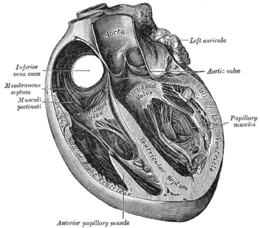Pectinate muscles
| Pectinate muscles | |
|---|---|
 Section of the heart showing the ventricular septum. (Pectinate muscles labeled at center left.) | |
| Details | |
| Identifiers | |
| Latin |
Musculi pectinati atrii dextri, musculi pectinati atrii sinistri |
| Dorlands /Elsevier | m_22/12550106 |
| TA |
A12.1.01.008 A12.1.03.003 |
| FMA | 76529 |
The pectinate muscles (musculi pectinati) are parallel ridges in the walls of the atria of the heart. They resemble the teeth of a comb, hence the name (which derives from Latin pecten, meaning "comb" or "rake").
Behind the crest (crista terminalis) of the right atrium the internal surface is smooth. Pectinate muscles make up the part of the wall in front of this, the right atrial appendage.
In the left atrium, the pectinate muscles, fewer and smaller than in the right atrium, are confined to the inner surface of its atrial appendage. This is due to the embryological origin of the auricles, which are the true atria. Some sources cite that the pectinate muscles are useful in increasing the power of contraction without increasing heart mass substantially.
Pectinate muscles of the atria are different from the trabeculae carneae which are found on the inner walls of both ventricles. The pectinate muscles originate from the crista terminalis.
References
This article incorporates text in the public domain from the 20th edition of Gray's Anatomy (1918)
External links
- -2066743237 at GPnotebook
- MedEd at Loyola grossanatomy/dissector/labs/thorax/heart/he3_1b.htm
- Anatomy photo:20:13-0104 at the SUNY Downstate Medical Center
- Atlas image: ht_rt_atrium at the University of Michigan Health System - "Right atrium, internal structure, anterior view"